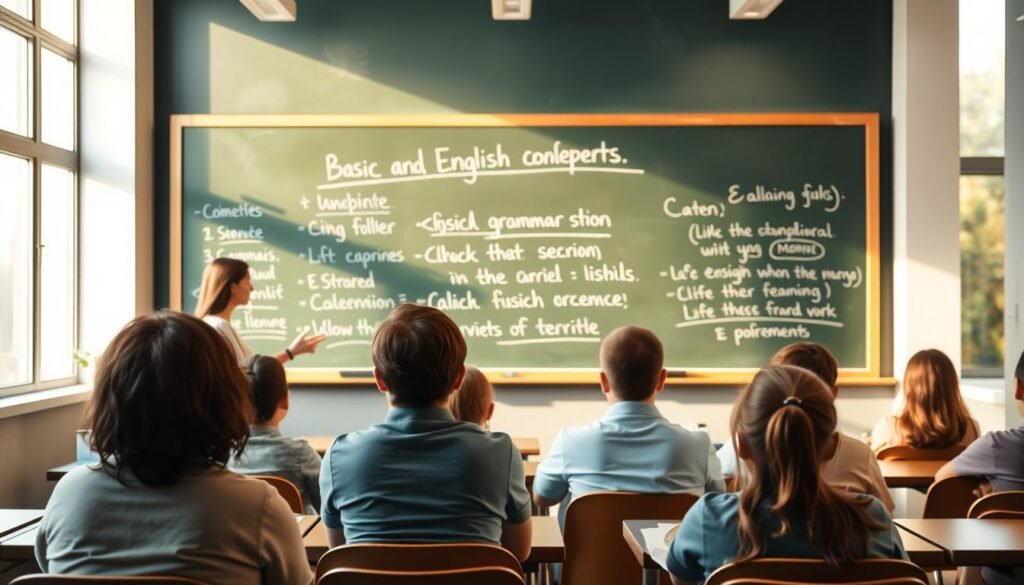Now Reading: The Verb ‘To Be’ + Adjectives, Basic English Grammar Lesson
-
01
The Verb ‘To Be’ + Adjectives, Basic English Grammar Lesson
The Verb ‘To Be’ + Adjectives, Basic English Grammar Lesson

The Verb ‘To Be’ + Adjectives, Basic English Grammar Lesson
The verb ‘to be’ and adjectives are key to describing people, feelings, and situations in English. Sentences like “I am excited” or “She is busy” use this rule. This lesson teaches how to use ‘to be’ with adjectives correctly.

Key Takeaways
- Mastering ‘to be’ + adjectives builds sentences like “They are happy” or “He is tired”.
- Errors like “You am happy” show the need to learn correct ‘to be’ forms (am/is/are).
- Everyday phrases depend on this structure for clarity and correctness.
- Basic English learners gain confidence by understanding subject-verb-adjective agreement.
- Examples like “We are ready” highlight how this rule works in real conversations.
Understanding the Fundamentals of the Verb ‘To Be’
The verb to be is a key part of English grammar. It links subjects to descriptions, places, or identities. For those learning, knowing how to use it is crucial for clear sentences. Let’s look at how it’s used in everyday talk.
The Role of ‘To Be’ in English Sentences
To be acts as a linking verb. It connects subjects to adjectives, nouns, or phrases that describe them. For example, She is happy or New York is a city. This is the foundation of descriptive communication, a major part of english grammar tutorial programs.
Different Forms: Am, Is, Are
These three forms match the subject:
- Am pairs with I (e.g., I am excited).
- Is matches singular third-person subjects (e.g., He is tired).
- Are fits plural subjects and you (e.g., We are ready).
Matching the subject with the right verb avoids confusion. This is a big point in learn english grammar courses.
When and Why We Use ‘To Be’
To be is not just for linking. It shows existence (There is a book), states (They are students), and helps in progressive tenses (She is writing). Using it correctly makes sentences clearer and more precise.
The Essential Structure: Subject + ‘To Be’ + Adjective
The verb to be + adjectives makes English descriptions clear. This setup links a subject to its qualities. For instance: “The room is clean” or “Students are focused”. Always keep the order: subject + correct form of “to be” + adjective.
Adjectives with to be answer questions like “How?” or “What’s the state?” Not all sentences with “to be” use adjectives. Compare:
| Correct | Incorrect |
|---|---|
| “She is happy” | “She is a teacher” |
| Adjective describes state | Noun follows “to be” |
Use the correct form of “to be” for each subject. Mistakes like “They am tired” break this pattern. Adjectives must come after “to be,” not before. Practice examples:
- “Coffee is hot”
- “They are ready”
- “This book is interesting”
Keep the word order to avoid confusion. Adjectives without “to be” can’t describe alone. This structure builds foundational grammar skills for clear communication.
Forms of ‘To Be’ Based on Subject Pronouns
Learning the verb ‘to be’ begins with knowing its different forms. This part of the basic english grammar lesson explains how to pair subjects with verbs correctly.
First Person: I Am
Use ‘I am’ when talking about yourself. Here are some examples:
- I am happy today.
- I am learning English daily.
Second Person: You Are
For talking to others, use ‘you are’. It works for one person or a group:
- You are here now.
- You (all) are ready to begin.
Third Person: He/She/It Is
Singular subjects need ‘is’:
- He is a teacher.
- She is friendly.
- It is raining outside.
Plural Forms: We/You/They Are
Groups or multiple people use ‘are’:
- We are excited to start.
- They are here today.
Mixing up verbs with subjects is a common mistake. For example, saying ‘he are’ is wrong. To get better, practice these forms in sentences. The learn english grammar path needs you to remember these rules well.
The Verb ‘To Be’ + Adjectives: Basic English Grammar Lesson
Learning to be verb + adjectives examples is key in the english grammar tutorial. This structure is crucial for making descriptive sentences. It helps us clearly share feelings, conditions, and traits.
Why This Combination Is Fundamental
This pattern is essential for basic communication. Phrases like “The sky is blue” or “We are ready” share important info. Without it, expressing simple ideas becomes hard.
For instance, describing emotions (“She feels sad”) or states (“The room is quiet”) depends on this structure.
Common Mistakes to Avoid
- Missing the verb: Incorrect: “He tired.” → Correct: “He is tired.”
- Incorrect verb forms: “You am busy” → “You are busy.”
- Adjective placement errors: “The movie bored me” → “The movie was boring.”
- Subject-verb disagreement: “My friends is happy” → “My friends are happy.”
Practice with sentences like “They are hungry” or “It is important” to avoid mistakes. Regularly reviewing english grammar tutorial materials helps you get it right over time.
Simple Adjectives to Use with ‘To Be’
Learning adjectives with to be begins with common words. These describe qualities of people, places, or situations. Here are some main categories and examples:
- Feelings: happy, sad, tired, excited
- Physical traits: tall, short, strong, small
- States: hot, cold, clean, busy
Here are some to be verb + adjectives examples in use:
- She is happy today.
- The coffee is hot. Please wait.
- They are excited for the trip.
| Adjective Pair | Positive Sentence | Negative Sentence |
|---|---|---|
| Hot/Cold | The soup is hot. | The room is cold. |
| Big/Small | The apple is big. | The phone is small. |
Begin with these basic words. Practice using them with “to be” for better communication. Even beginners can create sentences like: “He is serious” or “We are ready.” Gradually add more words, including opposites, to improve your vocabulary.
Creating Descriptive Sentences in Present Tense
This section builds on the english grammar tutorial basics. It shows how to make clear sentences using “to be + adjective” in three ways: positive, negative, and questions. Let’s look at examples for each.

Positive Statements
Start with the subject + “to be” + adjective. Here are some examples:
- She is kind.
- We are ready.
- The weather is sunny.
Negative Statements
Add “not” after the verb for negatives. You often hear contractions like “isn’t” or “aren’t” in speech:
- He is not tall. → He isn’t tall.
- They are not late. → They aren’t late.
Question Formation
Make yes/no questions by swapping the subject and verb. For info questions, start with a question word:
| Positive | Negative | Yes/No Question | Info Question |
|---|---|---|---|
| I am tired. | I am not tired. | Are you tired? | Why are you tired? |
| She is happy. | She isn’t happy. | Is he happy? | How is he feeling? |
Practice these patterns every day to get better. The basic english grammar lesson structure helps make your conversations clear.
Expanding Your Adjective Vocabulary
Learning the verb to be + adjectives helps you express yourself better in learn english grammar. You can describe people, how they look, and their feelings with more detail.
Personality Adjectives
Use words like ambitious, generous, or reliable to talk about traits:
- “They are trustworthy leaders.”
- “He is impatient under pressure.”
Physical Description Adjectives
Describe how someone or something looks:
- “She is slender and athletic.”
- “The plant is overgrown and unhealthy.”
Emotion and Feeling Adjectives
Express feelings and moods:
- “We are excited for the trip!”
- “The soup is too spicy and uncomfortable to eat.”
| Category | Adjective | Example |
|---|---|---|
| Personality | Innovative | “They are innovative problem-solvers.” |
| Physical | Pale | “His face is pale from lack of sleep.” |
| Emotion | Thrilled | “She feels thrilled about the news.” |
Try using new words in everyday situations. Write about your friends, favorite movies, or daily activities. This will help you remember them better.
Practice Exercises for Mastering ‘To Be’ with Adjectives
Getting good at to be verb + adjectives examples takes practice every day. Start with these activities to get better at using adjectives with to be.
- Fill-in-the-Blank: Complete sentences with the correct form of to be.
Example: “The soup ___ hot.” (Answer: is)
Example: “They ___ excited for the trip.” (Answer: are) - Sentence Transformation: Rewrite sentences into questions or negatives.
Example: “She is happy.” → “Is she happy?” or “She isn’t happy.” - Creative Writing: Describe scenarios using adjectives.
Example: “Write three sentences about your weekend using to be and adjectives like tired, relaxed, or busy.”
| Exercise Type | Example Task |
|---|---|
| Pair Work | Ask and answer questions: “What ___ you feeling today?” “I ___ happy.” |
| Self-Quiz | Choose the correct form: “My teacher ___ strict/are strict.” (Answer: is) |
| Journal Entry | Describe a place: “The park ___ beautiful in autumn.” |

Do these exercises every day. See how fast you get better. Share your answers with friends or a tutor. Remember, the more you practice, the better you’ll get!
Common Challenges and Solutions for English Learners
Learning the basic english grammar lesson on “to be” and adjectives can be tricky. Here are some tips to help:
Confusion Between Am/Is/Are
Many learners get confused between “am,” “is,” and “are.” To solve this:
- Remember “I am, you are, he is” to get it right.
- Use flashcards to practice: She is tall. We are ready.
Adjective Placement Errors
In some languages, adjectives come before nouns. In English, they always come after to be:
“In Spanish, ‘la casa blanca’ becomes ‘the house is white’ in English.” – Common learner error
To fix it, repeat phrases like: They are happy. The sky is blue.
Subject-Verb Agreement Issues
Collective nouns like team or family can be confusing. Here are some rules:
- Singular subjects: The team is strong.
- Plural subjects: The group are excited (if focusing on individuals).
Practice regularly with learn english grammar exercises. Focus on one challenge at a time to see progress.
Conclusion: Building Your English Foundation with ‘To Be’ and Adjectives
Learning the verb to be + adjectives is key for clear talking. This english grammar tutorial shows how phrases like “I am happy” or “she is tired” are basic. They help us talk about feelings, states, and qualities every day.
Using examples like “we are ready” or “it is important” helps you get it right. Making sure to use the right verb forms and place adjectives correctly is important. This lesson’s exercises help you feel more confident in making sentences.
Getting this right is a big step towards better grammar. It helps you handle more complex sentences and speak more smoothly. Using these patterns in everyday life makes your speaking and writing better. Keep practicing to get even better at English.






























